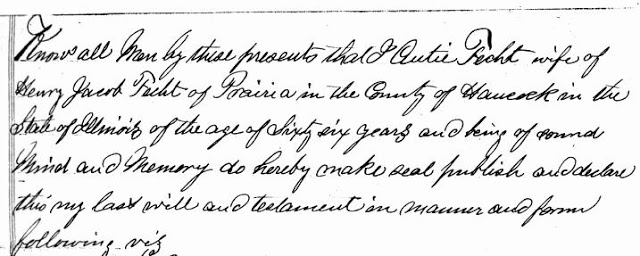Working only with transcriptions can sometimes be a hindrance. Handwriting sometimes itself is a clue. The original wills of Antje Fecht and Mimke Habben appear to be written by the same person. They were written approximately thirteen years apart.
There is no direct statement as to who wrote the wills. This is typical for the time and place. Wills from a later time period may include the name of the attorney, often on a cover sheet of sorts protecting the actual will. There is one clue also suggestive of the same person writing both documents: John B. Risse, a local attorney, was the witness on both documents. This suggests that he (or the same person in his employ) actually wrote the wills. The names of the other witnesses are different.
Now I’m wondering if there are other “same handwriting clues” that I have missed when I’ve only used my transcriptions of records.

Will of Mimke Habben, probated 1877 Hancock County, Illinois

Will of Antje Fecht, denied probate in Hancock County, Illinois, in 1900.
Join me for my upcoming online AncestryDNA class.

4 Responses
I would not have said these were written by the same person. Taking into consideration that this type of document followed a specific pattern, the handwriting itself is enough different that I would say two different people wrote them. Also considering they were written 13 years apart the handwriting could have changed enough to explain it but adults don’t usually change the way they form specific letters. The first example shows tall thin letters The bottom shows shorter squater letters. Some specific letters are not formed in exactly the same way. The general style is how letters were formed but the two examples don’t look like they were written by the same person.
I can see very specific similarities and would think they were written by the same hand. The word ‘and’ in both, the d is disconnected from ‘an’ and has the same curl back toward the front of the word; the M in men, the word ‘by’ in both samples, ‘know’ is very similar though the first sample is more ornate on the left line – I would not consider that negatively, the placement of ‘c’ in county. If not written by either of the individuals named, possibly written by a legal or family representative? I would respectfully disagree with Toni about adults not changing specific letters; my own changes, and has many times over the years, in style, slant, size given my mood or stresses on any given day, or whether I intentionally want to make a certain letter more “beautiful” – maybe I’m outside the norm. My grandmother’s changed considerably as she aged and had difficulty seeing; once beautiful penmanship, became a barely readable scratchy scrawl.
I agree with Toni that these were written by two different persons. The first one at first glance appears to be more smoothly written than the second one.
I agree with others – I don’t think these were written by the same person, although the handwriting is very similar. We must keep in mind that handwriting was an art – and very stylized – so persons who took care with their handwriting would have handwriting similar to others who also took care. Here are examples of why I think these samples were written by two different hand – look at the words “of sound mind” in the two examples.
The rendition of the letter “d” in the word “sound” is significantly different. Also notice the upswing of the letter “d” in the first example – but no upswing of this letter in the second example, also other letters include an upswing.